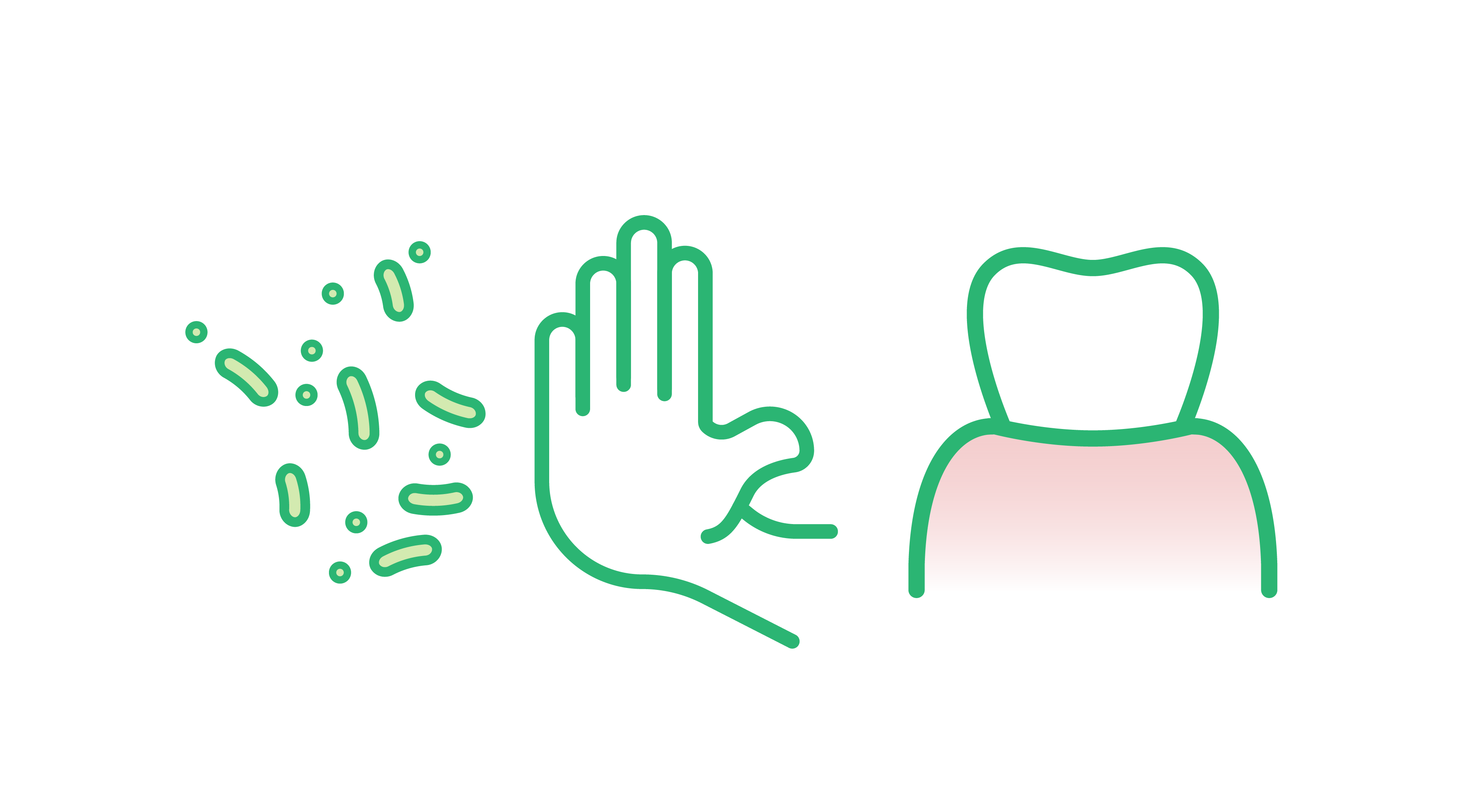
What Is Oral Microbiome? A Simplified Guide to Understanding Your Mouth’s Ecosystem
Ecosystems organically take form in a vast assortment of places, both in nature and within our own bodies. It’s one of the cool things about biology and life. You might be surprised by the complexity of the ecosystem within your own mouth.

To understand this ecosystem and why it’s important to dental care, you’ll first want to understand the concepts of biomes and microbiomes.
Biomes are communities of flora and fauna that form in response to the conditions of their natural environment. Those environmental conditions will dictate what type of biome develops – for instance, a dry, arid climate fosters the flora and fauna of a desert biome. As conditions change, the flora and fauna present can change, too.
What, then, is a microbiome? Much like their larger counterpart, microbiomes are communities of organisms that flourish within their given environment, but on a microscopic scale.
And rather than being located within a broad geographical region, they’re found in smaller spaces – such as on our bodies and even inside our mouths.
The oral microbiome
While it may be off-putting to think about having a vast number of microscopic organisms residing inside our mouths, those microbes will be there whether we think about them or not. So, in the best interest of personal health, it’s worth having at least a passing familiarity with what a healthy oral microbiome looks like.
Population
The human mouth is host to roughly 700 varieties of microorganisms. In total, the population of an average oral microbiome is roughly 6 billion microbes. No, that was not a typo! We each carry the equivalent of three-quarters of the world’s population in microbes inside our mouths.
Demographics
These microbes consist of bacteria, viruses, and fungi. The important thing to remember is that, for the most part, the oral microbiome exists in a state of symbiosis, with the microorganisms having a healthy balance and beneficial exchanges with one another.
Distribution
Much like violets growing in dappled forest floors and woodpeckers nesting in hollow branches, the organisms within the oral microbiome have places they call home as well. For example, some thrive on hard surfaces like teeth, while others prefer soft tissues like the tongue and oral mucosa.
Numbered among the vast population of microorganisms residing in the oral microbiome are several beneficial microbes that work day in and day out, helping maintain balance in our bodies.
Some good bacteria can be added to help tip towards a beneficial balance. Indeed, probiotics are live microorganisms which when administered in adequate amounts confer a health benefit to the host, according to FAO and WHO joint definition.
Probiotics have been identified as having a net-beneficial impact on the well-being of the host. Probiotic supplements are expected to positively modify the microbiome by bringing more beneficial bacteria, either to strengthen or restore it. When these probiotics reach our guts, they aid with digestion. In the oral microbiome, they fight against harmful microbes that threaten our oral – and whole-body – health.

Harmful microbes
The impact of harmful microbes that fester and multiply is much more noticeable since they disrupt our well-being. Let’s explore what these microbes are and the harmful effects they cause.
Common harmful microbes
- Streptococcus mutans: These bacteria are among the most well-known culprits for causing tooth decay. They metabolize sugars from the foods we eat and produce acids as byproducts, leading to the demineralization of tooth enamel and the formation of cavities.
- Porphyromonas gingivalis: This bacterium is associated with periodontal disease, a severe form of gum disease. P. gingivalis can thrive in the spaces between the gums and teeth, causing inflammation, gum recession, and potential tooth loss if left untreated.
- Tannerella forsythia: Another bacterium linked to periodontal disease, T. forsythia, contributes to the formation of dental plaque and triggers an immune response that can harm gum tissues.
- Aggregatibacter actinomycetemcomitans: What a mouthful! This bacterium is often associated with aggressive periodontitis, which can progress rapidly and lead to significant damage to the gums and supporting structures of the teeth.
- Prevotella intermedia: P. intermedia is another bacterium commonly found in dental plaque and implicated in periodontal disease.
- Candida albicans: Although typically present in small numbers, an overgrowth of this fungus can lead to oral thrush, a condition characterised by white patches on the tongue, inner cheeks, and other areas of the mouth.
- Fusobacterium nucleatum: This bacterium plays a role in forming biofilms on tooth surfaces and is involved in the development of periodontal disease.
- Treponema denticola: This bacterium is often found in association with periodontal pockets and is considered one of the key pathogens in periodontal disease.
It's essential to note that the oral microbiome exists in a dynamic balance, and the presence of these harmful organisms does not necessarily guarantee oral health problems. In a healthy oral microbiome, beneficial bacteria, viruses, and fungi maintain a balance with the harmful ones, preventing them from causing significant issues.
Negative health effects of harmful microbes
Some negative health effects caused by harmful microbes in our oral microbiome include:
Bad breath (halitosis)
Harmful microbes in our mouths produce foul-smelling gases as they feed on leftover food particles. These gases can lead to persistent bad breath, causing social discomfort and decreased confidence in social interactions
Plaque
Plaque is a sticky film that forms on our teeth due to the accumulation of harmful microbes, food particles, and saliva. Over time, if not properly removed through regular brushing and flossing, plaque can harden into tartar, which contributes to tooth discoloration and increases the risk of cavities.
Tooth decay (dental caries)
The harmful microbes in our mouths thrive on sugars from the food we eat. As they consume these sugars, they produce acids that attack the enamel, which is the protective outer layer of our teeth. This acid erosion weakens the enamel, leading to the formation of cavities or dental caries. If untreated, cavities can grow larger and reach the inner layers of the tooth, causing pain, sensitivity, and the need for costly dental treatments.
Gum disease (Periodontitis)
Plaque, if not effectively removed, can irritate and inflame the gums, leading to a condition called gingivitis, which is an early stage of gum disease. If left untreated, gingivitis can progress to periodontitis. Harmful microbes in plaque release toxins that further damage the gums and supporting tissues around the teeth. As a result, the gums may recede, creating pockets where even more harmful microbes can thrive. Over time, this can lead to the destruction of bone and ligaments that hold the teeth in place, potentially leading to tooth loss.
When harmful bacteria are allowed to flourish, that’s when health problems begin to manifest. Oral health problems can be an early indicator of greater health issues, like cardiovascular disease and diabetes.
Inside the matrix
No, this is not a pop-culture reference – well, not exactly. Much like the Matrix from the movies, the matrix in the oral microbiome shields the organisms it plays host to, but that’s where the similarities end.
Biofilm
Biofilm is a thin layer of microorganisms, such as bacteria, that coat the surfaces of their environment. Once a biofilm is established, a matrix forms to protect the communities of bacteria.
In the oral microbiome, the matrix houses both beneficial and harmful microbes, enabling those bacteria to establish a stronghold – for better or for worse. Plaque is a biofilm that contains an accumulation of bacteria that are responsible for gum inflammation and decay.
Feeding the biofilm
These matrices eventually develop systems that ensure bacteria in the biofilm are supplied with nourishment. As part of their digestive process, bacteria release enzymes. Some of these enzymes turn sugars into acids, which promote the development of caries.
How an unbalanced oral microbiome may impact overall health
When the oral microbiome is unbalanced, with an overgrowth of harmful bacteria and a decline in beneficial microbes, it can lead to various health implications beyond the mouth. Let’s explore the potential links between an imbalanced oral microbiome and its impact on overall health.
Inflammation
An unbalanced oral microbiome can trigger chronic inflammation in the mouth, leading to conditions such as gingivitis and periodontitis. However, this chronic inflammation can also contribute to systemic inflammation, affecting other parts of the body. Elevated levels of inflammation are linked to various health issues, including cardiovascular disease, diabetes, and autoimmune conditions.
Cardiovascular health
Emerging research suggests a possible connection between oral health and cardiovascular health. The bacteria that cause gum disease can enter the bloodstream through inflamed gums, potentially leading to inflammation in blood vessels and an increased risk of atherosclerosis (hardening of the arteries) and heart disease.
Brain health
Some studies have indicated that the oral microbiome may influence brain health. The chronic inflammation caused by an imbalanced oral microbiome could trigger a systemic inflammatory response, impacting the brain and potentially contributing to neurodegenerative diseases such as Alzheimer's and dementia.
Diabetes
Gum disease, often associated with an imbalanced oral microbiome, has been linked to insulin resistance and poorly controlled diabetes. The inflammation caused by gum disease may worsen insulin resistance and make it more challenging for individuals with diabetes to manage their blood sugar levels effectively.
Obesity
Recent research has suggested a possible link between oral bacteria and obesity. An unbalanced oral microbiome might influence the gut microbiome and metabolism, potentially contributing to weight gain and obesity.
Cancer
While the direct link between an unbalanced oral microbiome and cancer is still being explored, some studies have indicated associations between certain oral bacteria and an increased risk of certain cancers, including oral cancer and pancreatic cancer.
Autoimmune conditions
An imbalanced oral microbiome can contribute to the dysregulation of the immune system. This dysregulation may increase the risk of autoimmune conditions, where the immune system mistakenly attacks healthy cells and tissues.
Overall, the oral microbiome's balance is crucial for maintaining oral health and can significantly influence various aspects of overall health. A balanced oral microbiome, with a diverse array of beneficial microorganisms, supports the body's natural defences, aids in digestion, and helps prevent harmful bacteria from causing systemic issues.
Maintaining a healthy balance in the oral microbiome
The key to nurturing a balanced oral microbiome lies in a combination of proactive measures, such as good oral hygiene practices, limiting the accumulation of bacteria, and carefully controlling the nourishment that reaches the biofilm within the matrix. Through these measures, we can effectively support the growth of beneficial bacteria and safeguard our oral and overall health.
Let's explore these essential practices in detail to understand how to achieve and maintain a harmonious oral microbiome.
Stop feeding harmful bacteria
Avoid sugary foods and drinks
Sugars, especially refined sugars and carbohydrates, serve as a primary food source for harmful bacteria within the oral microbiome. When we consume sugary foods and drinks, these bacteria metabolise the sugars and produce acids as byproducts. These acids can erode the enamel, the protective outer layer of our teeth, leading to tooth decay and cavities. Additionally, the excess sugar in the mouth can create an environment conducive to the growth of harmful bacteria, disrupting the natural balance of the oral microbiome.
Limit smoking and tobacco use
Smoking and tobacco use are detrimental to oral health and can disrupt the balance of the oral microbiome. The chemicals present in tobacco products can cause irritation and inflammation of the gums, leading to a higher risk of gum disease. Additionally, smoking weakens the immune system, making it harder for the body to fight off harmful bacteria in the mouth.
Moderate alcohol intake
Excessive alcohol consumption can have several negative effects on oral health. Alcohol is known to cause dry mouth, reducing saliva production. Saliva plays a vital role in maintaining a healthy oral environment by washing away food particles and neutralising acids. A dry mouth can create an ideal environment for harmful bacteria to thrive, leading to an imbalance in the oral microbiome.
Practice a complete oral care ritual
By making complete oral care part of your twice-daily ritual to remove plaque, you can play a proactive part in balancing your oral microbiome.

This ritual consists of:
1. Cleaning between your teeth with interdental cleaners like floss, picks, and special brushes. Cleaning interdentally, whether it’s with floss or an interdental pick, plays a critical role in oral hygiene by targeting the areas between teeth and along the gumline that toothbrushes cannot reach.
These spaces often trap food particles and plaque, which, if left untouched, can lead to cavities and gum inflammation. Interdental cleaning helps dislodge debris and disrupt the formation of plaque, contributing to a healthier oral microbiome and reducing the risk of gum disease.
2. Brushing your teeth correctly and thoroughly with the right toothbrush and toothpaste. Regular and proper brushing is the foundation of a healthy oral hygiene routine. Brushing removes food particles, plaque, and bacteria from the surfaces of teeth and gums, preventing the buildup of harmful substances that can lead to cavities and gum disease.
3. Rinsing your mouth to remove remaining debris.
Mouthwash and oral rinses are valuable additions to oral hygiene routines as they offer several benefits. Mouthwash can reduce the amount of bacteria in the mouth, helping to control bad breath and prevent plaque buildup. Some mouthwashes contain fluoride, providing an additional layer of protection against tooth decay. Antimicrobial mouthwashes can help reduce gum inflammation and prevent gingivitis.
Get regular dental check-ups and cleanings
Regular dental check-ups and cleanings are essential components of a comprehensive oral health routine. Dentists play a crucial role in maintaining oral health by providing professional care, expertise, and personalised guidance.

